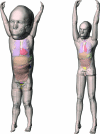Patient-specific radiation dose and cancer risk estimation in CT: part II. Application to patients
- PMID: 21361209
- PMCID: PMC3021563
- DOI: 10.1118/1.3515864
Patient-specific radiation dose and cancer risk estimation in CT: part II. Application to patients
Abstract
Purpose: Current methods for estimating and reporting radiation dose from CT examinations are largely patient-generic; the body size and hence dose variation from patient to patient is not reflected. Furthermore, the current protocol designs rely on dose as a surrogate for the risk of cancer incidence, neglecting the strong dependence of risk on age and gender. The purpose of this study was to develop a method for estimating patient-specific radiation dose and cancer risk from CT examinations.
Methods: The study included two patients (a 5-week-old female patient and a 12-year-old male patient), who underwent 64-slice CT examinations (LightSpeed VCT, GE Healthcare) of the chest, abdomen, and pelvis at our institution in 2006. For each patient, a nonuniform rational B-spine (NURBS) based full-body computer model was created based on the patient's clinical CT data. Large organs and structures inside the image volume were individually segmented and modeled. Other organs were created by transforming an existing adult male or female full-body computer model (developed from visible human data) to match the framework defined by the segmented organs, referencing the organ volume and anthropometry data in ICRP Publication 89. A Monte Carlo program previously developed and validated for dose simulation on the LightSpeed VCT scanner was used to estimate patient-specific organ dose, from which effective dose and risks of cancer incidence were derived. Patient-specific organ dose and effective dose were compared with patient-generic CT dose quantities in current clinical use: the volume-weighted CT dose index (CTDIvol) and the effective dose derived from the dose-length product (DLP).
Results: The effective dose for the CT examination of the newborn patient (5.7 mSv) was higher but comparable to that for the CT examination of the teenager patient (4.9 mSv) due to the size-based clinical CT protocols at our institution, which employ lower scan techniques for smaller patients. However, the overall risk of cancer incidence attributable to the CT examination was much higher for the newborn (2.4 in 1000) than for the teenager (0.7 in 1000). For the two pediatric-aged patients in our study, CTDIvol underestimated dose to large organs in the scan coverage by 30%-48%. The effective dose derived from DLP using published conversion coefficients differed from that calculated using patient-specific organ dose values by -57% to 13%, when the tissue weighting factors of ICRP 60 were used, and by -63% to 28%, when the tissue weighting factors of ICRP 103 were used.
Conclusions: It is possible to estimate patient-specific radiation dose and cancer risk from CT examinations by combining a validated Monte Carlo program with patient-specific anatomical models that are derived from the patients' clinical CT data and supplemented by transformed models of reference adults. With the construction of a large library of patient-specific computer models encompassing patients of all ages and weight percentiles, dose and risk can be estimated for any patient prior to or after a CT examination. Such information may aid in decisions for image utilization and can further guide the design and optimization of CT technologies and scan protocols.
Figures



Similar articles
-
Patient-specific dose estimation for pediatric chest CT.Med Phys. 2008 Dec;35(12):5821-8. doi: 10.1118/1.3026593. Med Phys. 2008. PMID: 19175138 Free PMC article.
-
Organ doses, effective doses, and risk indices in adult CT: comparison of four types of reference phantoms across different examination protocols.Med Phys. 2012 Jun;39(6):3404-23. doi: 10.1118/1.4718710. Med Phys. 2012. PMID: 22755721 Free PMC article.
-
Estimating lung, breast, and effective dose from low-dose lung cancer screening CT exams with tube current modulation across a range of patient sizes.Med Phys. 2018 Oct;45(10):4667-4682. doi: 10.1002/mp.13131. Epub 2018 Sep 24. Med Phys. 2018. PMID: 30118143 Free PMC article.
-
Effects of protocol and obesity on dose conversion factors in adult body CT.Med Phys. 2012 Nov;39(11):6550-71. doi: 10.1118/1.4754584. Med Phys. 2012. PMID: 23127050 Free PMC article.
-
Organ doses for reference pediatric and adolescent patients undergoing computed tomography estimated by Monte Carlo simulation.Med Phys. 2012 Apr;39(4):2129-46. doi: 10.1118/1.3693052. Med Phys. 2012. PMID: 22482634 Free PMC article.
Cited by
-
Radiation Dose during Digital Subtraction Angiography of the Brain-The Influence of Examination Parameters and Patient Factors on the Dose.Brain Sci. 2024 Aug 9;14(8):799. doi: 10.3390/brainsci14080799. Brain Sci. 2024. PMID: 39199491 Free PMC article.
-
Patient-based estimation of organ dose for a population of 58 adult patients across 13 protocol categories.Med Phys. 2014 Jul;41(7):072104. doi: 10.1118/1.4883778. Med Phys. 2014. PMID: 24989399 Free PMC article.
-
Comparison of conventional and simulated reduced-tube current MDCT for evaluation of suspected appendicitis in the pediatric population.AJR Am J Roentgenol. 2013 Sep;201(3):651-8. doi: 10.2214/AJR.12.9667. AJR Am J Roentgenol. 2013. PMID: 23971460 Free PMC article.
-
Radiation risks associated with serial imaging in colorectal cancer patients: should we worry?World J Gastroenterol. 2014 Jan 7;20(1):100-9. doi: 10.3748/wjg.v20.i1.100. World J Gastroenterol. 2014. PMID: 24415862 Free PMC article. Review.
-
Using body mass index to estimate individualised patient radiation dose in abdominal computed tomography.Eur Radiol Exp. 2018 Nov 28;2(1):38. doi: 10.1186/s41747-018-0070-5. Eur Radiol Exp. 2018. PMID: 30483977 Free PMC article.
References
-
- Hurwitz L. M., Yoshizumi T. T., Goodman P. C., Nelson R. C., Toncheva G., Nguyen G. B., Lowry C., and Anderson-Evans C., “Radiation dose savings for adult pulmonary embolus 64-MDCT using bismuth breast shields, lower peak kilovoltage, and automatic tube current modulation,” AJR, Am. J. Roentgenol. AAJRDX 192, 244–253 (2009).10.2214/AJR.08.1066 - DOI - PubMed
-
- Cristy M. and Eckerman K. F., “Specific absorbed fractions of energy at various ages from internal photon sources,” Oak Ridge National Laboratory Report No. ORNL/TM-8381.

